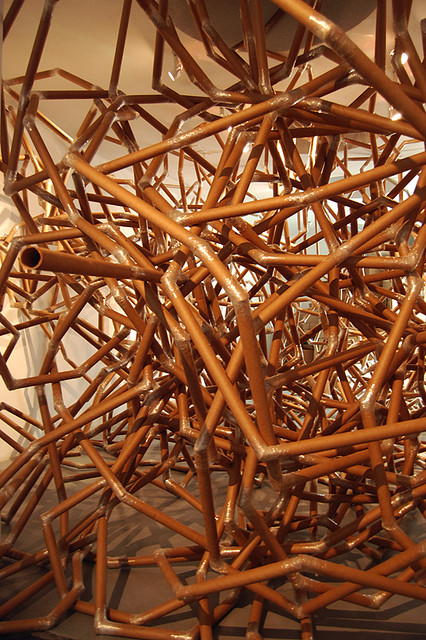



INVISIBLE CAR
MERCEDES-BENZ “Invisible Drive”
The Mercedes-Benz F-CELL is the first hydrogen-powered car, which is ready for series production. With a spectacular action we draw a suitable attention to this innovation: We made people experience F-CELL the same way the environment does – like it’s not even existent. In practice: We disguised the B-Class F-CELL with mats out of LEDs on the one side and fixed a camera on the other side of the car. The camera filmed everything that happened behind the vehicle and transferred every action directly to the LED mats. The effect: The B-Class fused completely with its surrounding and became invisible for the passersby in the immediate vicinity.
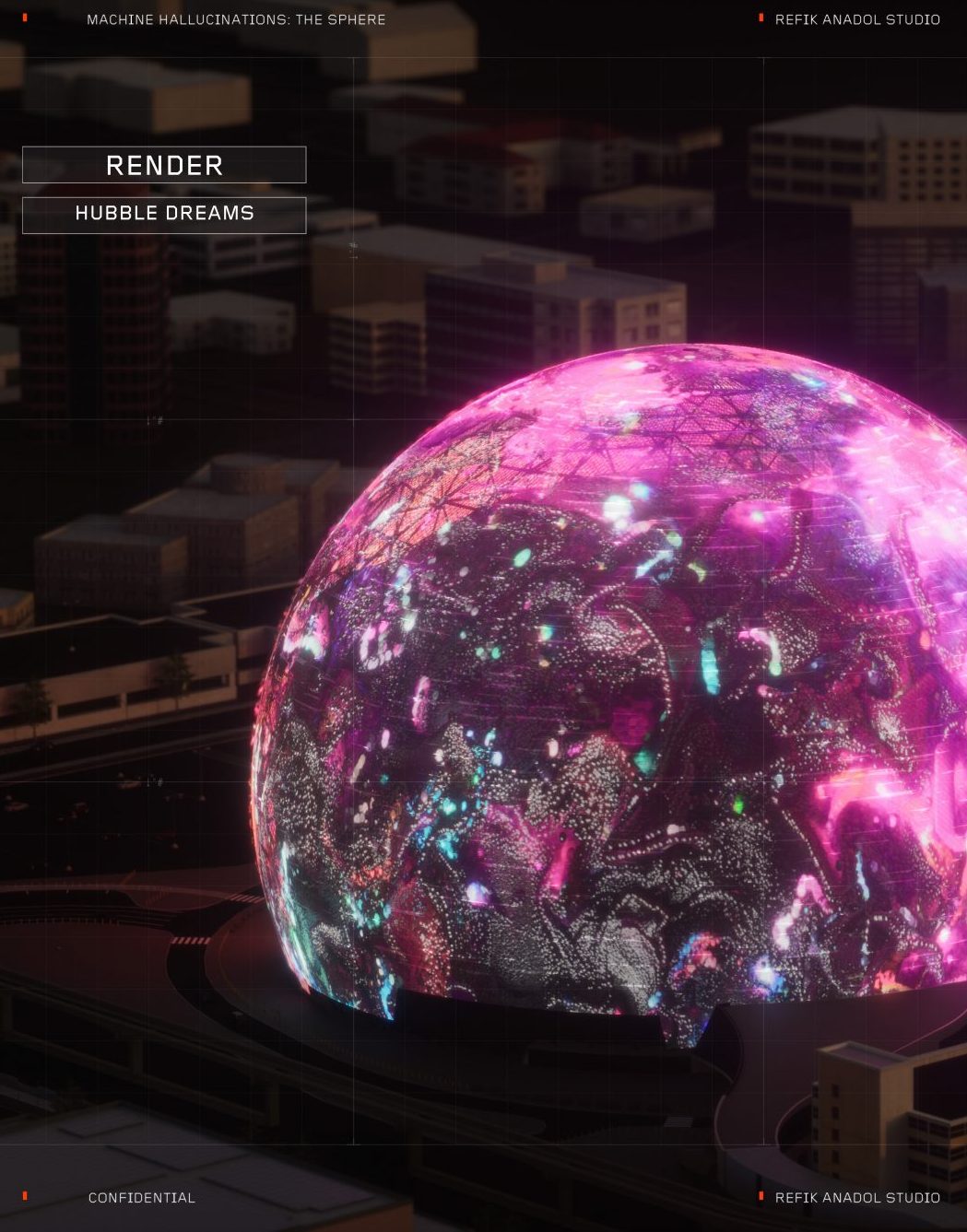
Refik Anadol
Machine Hallucinations — Sphere
The artwork presents a series of AI Data Sculptures that incorporates vivid pigments, shapes, and patterns, aiming to create a collective, meditative, and multisensory experience. This immersive experience simulates the rhythms of various environments and invites the visitors to imagine alternative realities constructed by invisible data movements around them.
Machine Hallucination: The Sphere features dynamic visualizations of data that are based on vast archives containing visual imageries of space and nature while celebrating the unique architecture of The Sphere. For this project, Anadol and his team used these themed datasets as the building blocks for the three distinct chapters of the artwork and trained a unique AI model with subsets of the collected image archives. After the training, when idle and unsupervised, the “machine mind” generates new aesthetic visuals and color combinations through unique lines drawn by algorithmic connections.

QUBIT AI: Banz & Bowinkel
Bots
FILE 2024 | Installations
International Electronic Language Festival
Bots presents a computer-controlled society through a series of algorithmically controlled humanoid avatars that appear on physical carpets using augmented reality (AR). Real-time performances synthesize human behavioral patterns into a formalized digital social study. Omnipresent, combined with our devices and incorporated into virtual environments, the work reminds us of our own digitalized world, in which we are surrounded by invisible bots.
Bio
Giulia Bowinkel (born 1983) and Friedemann Banz (born 1980) live in Berlin and have worked together under the name Banz & Bowinkel since 2009. In 2007 they graduated from the Art Academy with Albert Oehlen and started making art with computers . His work encompasses computer-generated imagery, animation, augmented reality, virtual realities and installations.

yoshio kubo
“DIFFERENT DIMENSION”
“Various winds are accumulated, pulled out, fluttered, rotated … Repeated over and over again. The invisible wind has the same expression for one second. Isn’t it possible to “see” with a dress that can’t be seen? It is a challenge to design your own style through dress making. ” yoshio kubo

Berenike Corcuera
Berenike Corcuera’s collection was inspired by kirilian photographs of her aura, first captured in Chinatown’s reowned Magic Jewelry. when she lived in New York in 2014. She began studying the electromagnetic field of the human body to understand how to translate the invisible. She began the practice of mandala and colour studies, to understand how metaphysical bodies could be interpreted into physical bodies and contemporary menswear clothing.

SpY
ORB
The shape of the piece alludes to the ‘pi’ number concealed in the geometry of the Pyramids, found when dividing the perimeter of a Pyramid by twice its height. The sphere is an invisible part of the resulting geometry, since a sphere with a radius as high as the Pyramid would have a circumference very close in length to the Pyramid’s perimeter. The surface of the artwork captures the Pyramids, the sky, the surroundings and the viewers in a multiple fragmented reflection. It references the role of the circular mirror in historical Egyptian symbolism, where it was linked to the sun and conveyed notions of creation and rebirth.

Iris van Herpen & Dutch National Ballet
Biomimicry
For the ‘Biomimicry’ film, Iris van Herpen and Dutch National Ballet explore the symbiotic relationship between the metamorphic force in which fashion and dance interlace. The film, directed by Ryan McDaniels, sees the mesmeric dancer JingJing Mao undulating into liquescent shapes and transcending into graceful figures that reflect her myriad of movements. The concept of the creation stems from the notion of biomimicry — the design and production of materials and systems that are modelled on biological processes. In line with Iris van Herpen’s continuous pursuit to materialise the invisible forces that structure the world, the film focusses on the bond between humanity and nature.

Mel O’callaghan
Pneuma
« Pneuma » de Mel O’Callaghan présenté dans notre exposition Seeing The Invisible, nous invite à nous joindre à une méditation de respiration rythmée alors que nous sommes confrontés à une sphère chatoyante de couleur et de lumière.

GUTO NÓBREGA
Breathing
File Festival
Breathing is a work of art based on a hybrid creature made of a living organism and an artificial system. The creature responds to its environment through movement, light and the noise of its mechanical parts. Breathing is the best way to interact with the creature.
This work is the result of an investigation of plants as sensitive agents for the creation of art. The intention was to explore new forms of artistic experience through the dialogue of natural and artificial processes. Breathing is a pre-requisite for life, and is the path that links the observer to the creature.Breathing is a small step towards new art forms in which subtle processes of organic and non-organic life may reveal invisible patterns that interconnect us.Breathing is a work of art driven by biological impulse. Its beauty is neither found isolated on the plant nor in the robotic system itself. It emerges at the very moment in which the observer approaches the creature and their energies are exchanged through the whole system. It is in that moment of joy and fascination, in which we find ourselves in a very strange dialogue, that a life metaphor is created.Breathing is the celebration of that moment.

Yonakani: Young ah Seong, Takuji Narumi & Tomohiro Akagawa
Thermotaxis
file festival
The term “Thermotaxis” signifies a movement of a living organism in response to heat stimulation. A thermal spot has power to encourage people to gather together like open fires in winter or water places in summer. The work “Thermotaxis” characterizes the open space as invisible thermal spots by providing people with thermal information. Our work aims to create a new spatial structure for communication not by architectural approach but by using information technology.
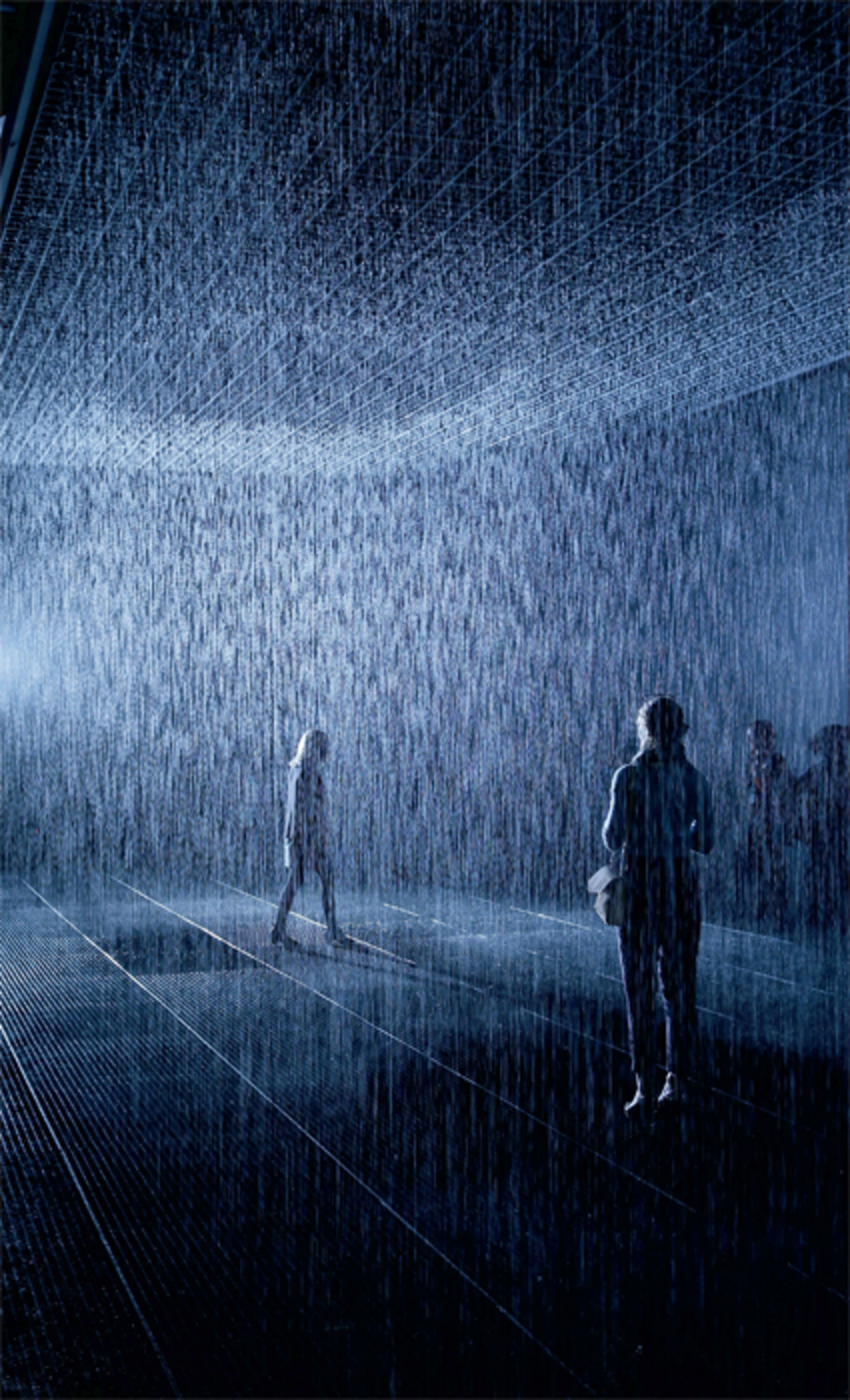
RANDOM INTERNATIONAL
Salle de pluie
Utilisant la technologie numérique, « Rain Room » est une averse soigneusement chorégraphiée, une œuvre monumentale qui encourage les gens à devenir des interprètes sur une scène inattendue, tout en créant une atmosphère intime de contemplation. Les visiteurs peuvent littéralement marcher sous la pluie, comme s’ils étaient entourés d’un champ magnétique invisible, et ne jamais se mouiller.

Claire Malrieux
Climat General College des Bernardins
Se référant à l’« Hypothèse Gaïa » de James Lovelock, Malrieux transforme la figure de Gaïa en une machine climatique autonome qui affiche un espace dynamique et organique, construit selon des flux de données empruntés aux principaux modèles climatiques prédictifs. A travers différents scénarios programmatiques, l’artiste met en évidence l’influence de l’homme sur son environnement, un environnement en perpétuelle mutation dont la fin ne peut être programmée. Car si l’entrée dans l’anthropocène marque la fin d’une Terre en extension, elle marque surtout le début d’autre chose : une situation différente dans le temps et dans l’espace. Un espace où le décor est en mouvance et dans lequel l’histoire humaine s’adapte et évolue.
L’usage simultané du dessin et des algorithmes permet de visualiser des interactions et des causes à effets habituellement invisibles, de les décoder et d’en interroger les enjeux.
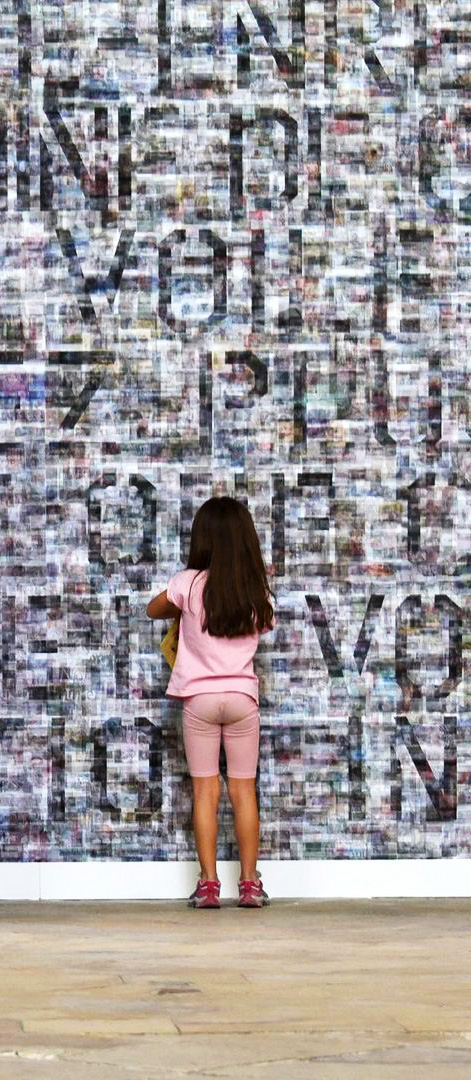
Pascal Dombis
La Génération Invisible
La Génération Invisible est une installation dans laquelle Pascal Dombis questionne notre rapport aux images numériques et comment nous les regardons aujourd’hui. Internet génère une profusion d’images qui circulent et qui sont de moins en moins regardées par les humains. Cette installation parle de la disparition des images de par leur circulation et prolifération excessive. Le mur est couvert par un flux de 30 000 images internet entrelacées formant une surface visuelle floue. La nature individuelle de chacune des images peut être décodée par l’utilisation d’une plaque lenticulaire que le visiteur applique directement contre le mur, afin d’en extraire de multiples lectures. Cette installation fait écho au travail de William Burroughs sur le langage et les images en reprenant une phrase d’un de ses livres Cut-Up de 1961 :

Frederik de Wilde
Ai Beetles
THIS NEXT NATURE POST-CAMOUFLAGE AI BEETLE IS INVISIBLE FOR THE ELECTRONIC EYE. THE PATTERNS ARE GENERATED WITH NEURAL NETWORKS AND EVOLUTIONARY ALGORITHMS TO FOOL AND MISLEAD ARTIFICIAL INTELLIGENCE ENABLED SYSTEMS. MY AIM IS TO DEVELOP A CONTEMPORARY RAZZLE DAZZLE STYLE CAPABLE OF MESSING UP LABELLING AND METADATA SYSTEMS. IT LOOKS LIKE A BEETLE FOR US BUT IS SEEN AS E.G. A HONEYCOMB FOR AN AI.
video

Refik Anadol
Quantum Memories: Nature Studies
Technological and digital advancements of the past century could as well be defined by the humanity’s eagerness to make machines go to places that humans could not go, including the spaces inside our minds and the non-spaces of our un- or sub-conscious acts. These unique pieces of the “Quantum Memories” series exhibit arresting visuals and colors that speculate the probability of reaching invisible spaces. They are composed in collaboration with a generative algorithm enabled by artificial intelligence (AI) and quantum computing, a new form of computing that exploits the unusual physics of the subatomic world. It turns the visual data that flows around us into an artwork that represents our collective and digitized memories of nature and encourages the viewer to imagine the potential of this computing technology for the future of art, design, and architecture.


Hussein Chalayan
フセイン·チャラヤン
ЧАЛАЯН
후세인 샬 라얀
Gravity Fatigue
Fashion designer Hussein Chalayan has created elasticated costumes and sequinned garments for performers in his first self-directed dance production (+ slideshow).The production is split into 18 chapters that each explore themes of identity, displacement and invisibility.

REMTY ELENGA
ALL THE SCREENS IN MY HOUSE
Her nearby environment and the observations she makes in it form the starting point for Remty Elenga (Los Angeles, 1987) in creating new work. In doing this she likes to explore how we give meaning to various layers of reality, looking for contradictions in time and place, the visible and invisible, between what is real and what isn`t.

RYUJI NAKAMURA
中村竜治
류지 나카무라
РЮДЗИ НАКАМУРА
spring (invisible 3D screen)
Japanese architect Ryuji Nakamura has constructed a nearly invisible 3D screen that only reveals itself in the presence of light. This installation ‘spring’ was part of the “Neoreal in the Forest” exhibit at this year’s Milan Design Week

Terreform ONE
PLUG-IN ECOLOGY: Urban Farm Pod with Agronomy
The Plug-In Ecology; Urban Farm Pod is a “living” cabin for individuals and urban nuclear families to grow and provide for their daily vegetable needs. It is an interface with the city, potentially touching upon urban farming, air quality levels, DIY agronomy techniques in test tubes, algal energy production, and bioluminescent light sources, to name a few possibilities. It can be outfitted with a number of optional systems to adapt to different locations, lighting conditions, and habitation requirements. While agricultural food sources are usually invisible in cities such as New York, the pod archetype turns the food system itself into a visible artifact, a bio-informatic message system, and a functional space.

Riccardo Torresi, Maxime Lethelier, Asako Fujimoto
Satellarium II
Sun Outage is a degradation or temporary interruption of satellite signal caused by solar radiation. In these moments satellites occur to be in between the Sun and the Earth, producing with their shadows an invisible eclipse. Satellarium II shows these astronomical events through a variation of visuals and sounds in the room in which it is exhibited. The installation consists of a set up of multi channel surround speakers and graphics projected on a disk above the viewers, representing the fragment of the visible sky from the location of the artwork. Visuals and sounds are based on real time tracking of the satellites position and magnitude (brightness of a satellite as it appears in the night sky from Earth). The gradient on the background of the projection represents the sun and it is related to its real-time position in the sky.

LUNDÉN ARCHITECTURE COMPANY
Une autre générosité
Another Generosity explore une nouvelle structure qui consiste en une membrane contenant deux éléments de base: l’air et l’eau. Les structures simples sont combinées pour créer une structure cellulaire visible et dynamique. Les éléments gonflés servent d’intermédiaire entre l’environnement naturel et bâti. Ils répondent à des stimuli externes et parfois invisibles, créant un nouveau type d’expérience, une hésitation momentanée qui augmente notre conscience de notre environnement.

One Life Remains: André Berlemont, Kevin Lesur, Brice Roy & Franck Weber
FILE SAO PAULO 2017
LES DISCIPLINES DU RECTANGLE
Inspired by Michel Foucault’s work, Les disciplines du rectangle is a videogame proposition about the nature of rules and norms at the digital age. If society provides models of accomplishment we are supposed to fit inside, then the rectangle is the pure abstraction of this idea. The geometrical shape works as a symbol of the very nature of normativity, blind to individual differences. The rectangle, existing only on the screen, reveals how digital technologies can in some ways become the new location for this normativity and the ambivalent results of their intangible and invisible nature. Besides, the installation offers an occasion to think about the way games can become manipulation tools. The fact that in the end, players act as if they were piloted by the rectangle (an inversion of the traditional relationship between player and avatar) gives an aesthetical highlight to this.
.
Inspirado en el trabajo de Michel Foucault, Les disciplines du rectangle es una propuesta de videojuego sobre la naturaleza de las reglas y normas en la era digital. Si la sociedad proporciona modelos de realización en los que se supone que encajamos, entonces el rectángulo es la pura abstracción de esta idea. La forma geométrica funciona como símbolo de la naturaleza misma de la normatividad, ciega a las diferencias individuales. El rectángulo, que existe solo en la pantalla, revela cómo las tecnologías digitales pueden convertirse de alguna manera en la nueva ubicación de esta normatividad y los resultados ambivalentes de su naturaleza intangible e invisible. Además, la instalación ofrece la oportunidad de pensar en cómo los juegos pueden convertirse en herramientas de manipulación. El hecho de que, al final, los jugadores actúen como si fueran piloteados por el rectángulo (una inversión de la relación tradicional entre jugador y avatar) le da un toque estético a esto.
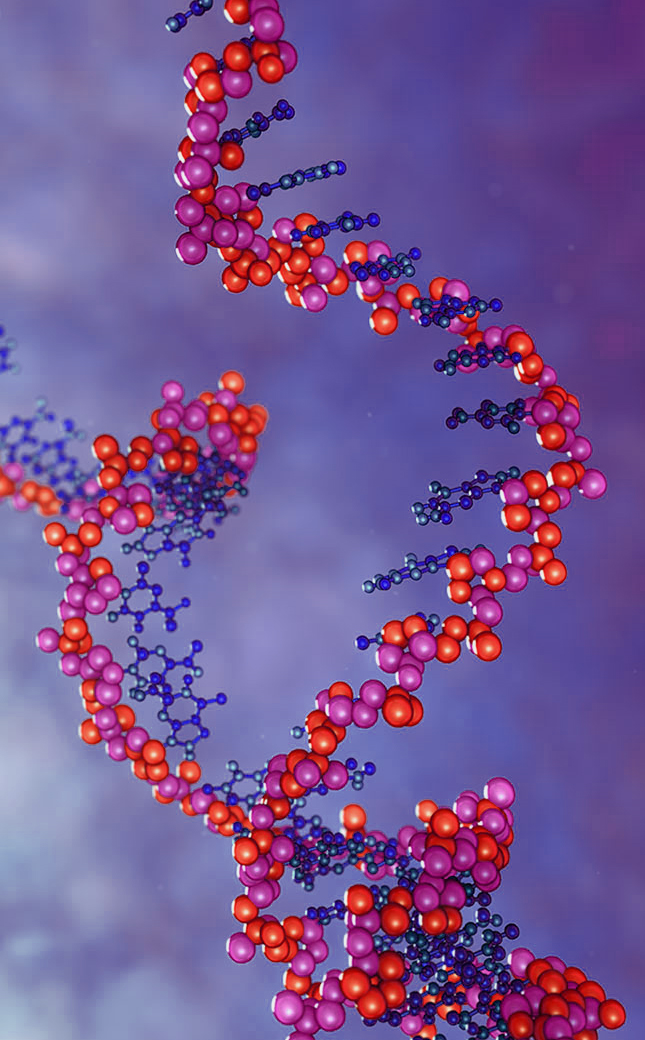
JOHN LIEBLER
Art of the Cell
Beneath our everyday world there is a miniature universe of cells, trillions of tiny worlds, unseen and beautiful. Here is our latest 3D medical demo reel, including clips from many of the projects we’ve worked on, such as “Biology:How Life Works”, and “The Inner Life of the Cell”. We hope that you enjoy this two and a half minute tour of the Art of the Cell.
.
Art de la cellule
Sous notre monde quotidien, il y a un univers miniature de cellules, des trillions de mondes minuscules, invisibles et beaux. Voici notre dernière démo médicale en 3D, comprenant des extraits de nombreux projets sur lesquels nous avons travaillé, tels que «Biologie: comment fonctionne la vie» et «La vie intérieure de la cellule». Nous espérons que vous apprécierez cette visite de deux minutes et demie de l’Art de la cellule.
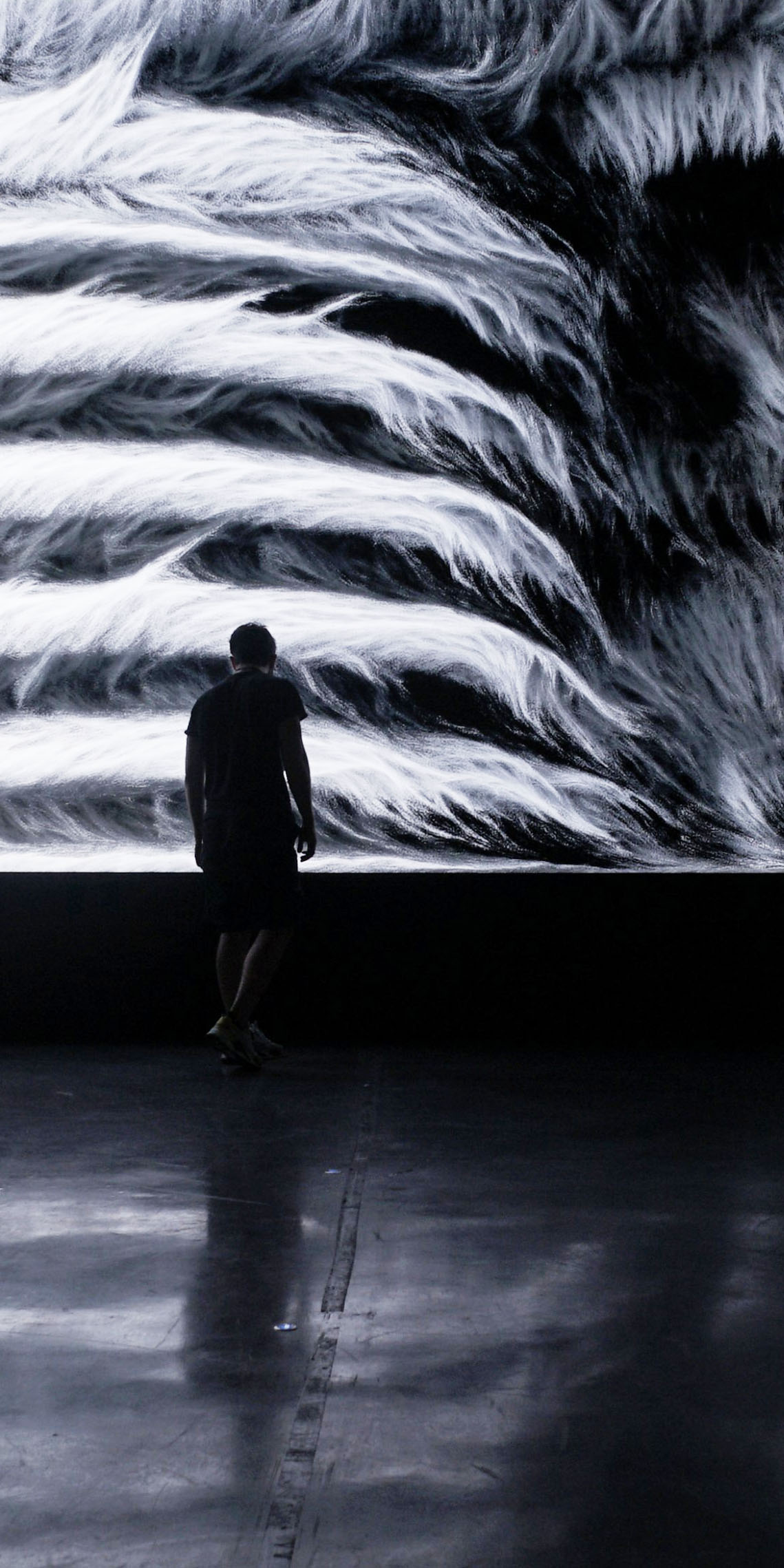
FUSE
Falin Mynd
Falin Mynd est une installation audiovisuelle dédiée à la ville de Milan qui s’inspire du concept de l’image latente dans le champ photographique: une empreinte invisible laissée par la lumière sur le film qui ne se révèle qu’après son développement. De même, les données générées par les habitants et les visiteurs de la ville de Milan produisent des paysages numériques abstraits, laissant une trace de leur analyse et interprétation en temps réel. De cette manière, le travail rend visible le lien indissoluble entre l’individu et la communauté, soulignant comment les deux entités s’influencent mutuellement en changeant la perception de la réalité qui nous entoure faite de lieux, de personnes, de couleurs et de sensations. Les données constituent ainsi une image invisible de la ville, une carte de ce qui n’est pas manifeste et qui se révèle dans Falin Mynd.

REFIK ANADOL STUDIOS
Vent de Boston: Data Paintings
Vent de Boston: Data Paintings est une œuvre spécifique au site qui transforme les motifs invisibles du vent dans et autour de Boston en une série de peintures de données poétiques dans une toile numérique de 6 x 13 pi. En utilisant un ensemble de données d’un an collecté à l’aéroport de Boston Logan, Refik Anadol Studios a développé une série de logiciels personnalisés pour lire, analyser et visualiser la vitesse, la direction et les rafales du vent ainsi que le temps et la température à des intervalles de 20 secondes tout au long de l’année. .
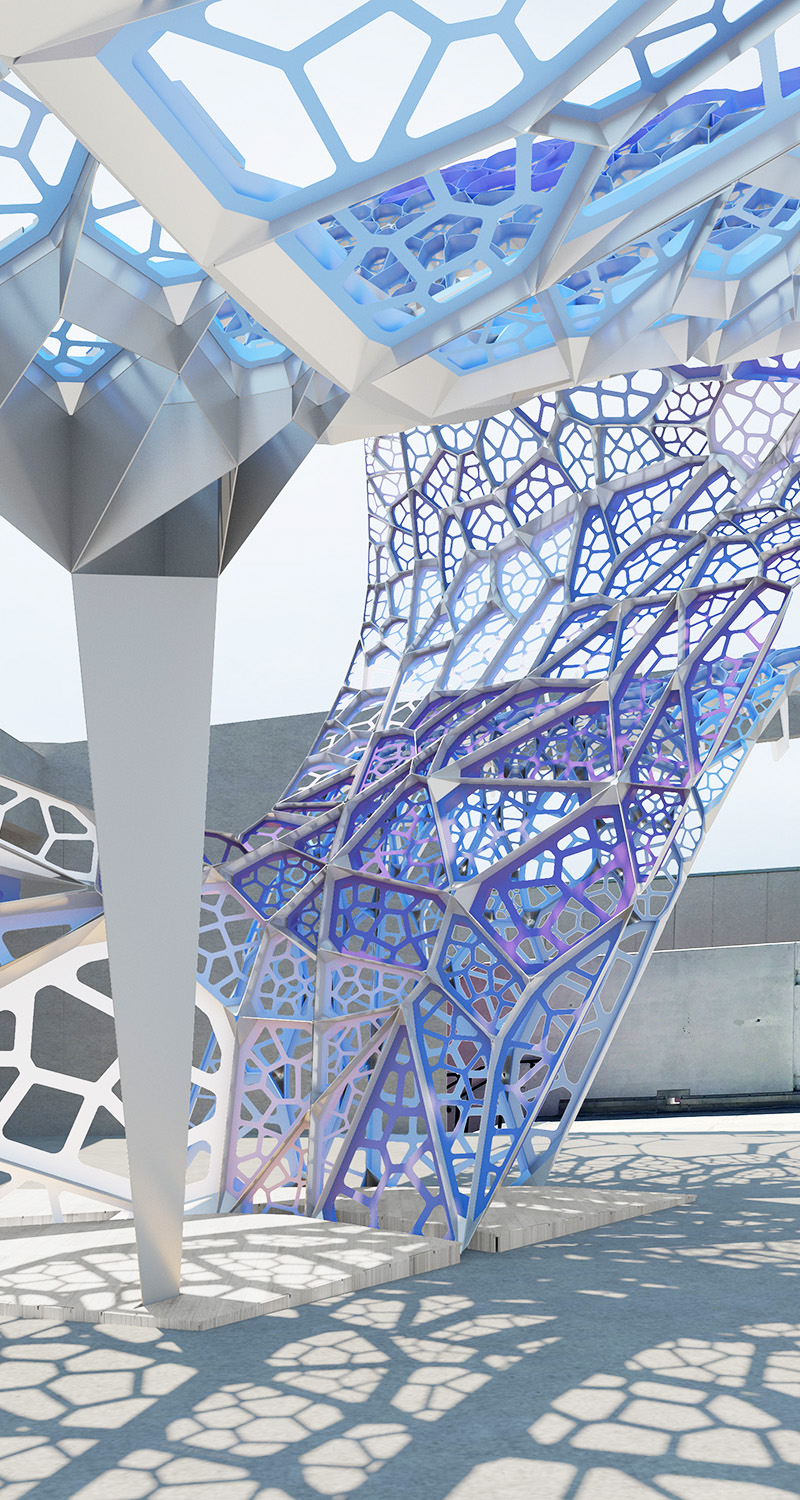
OTA+
Lumifoil
Lumifoil is a temporary roof canopy at the Florida International University Paul L. Cejas School of Architecture. Our goal was to introduce a new “intrusion” at the heart of what FIU Architect Bernard Tschumi coined the “red generator,” thereby heeding his call for provocation in the form of an architectural intervention. This proposal responds to Tschumi’s discourse and the building itself might apply to the parametric digital project. Rather than design a canopy that is entirely emergent – a bottom up strategy in which the whole is the sum of its parts, and be definition, disconnected from its environment – we began with an overall form that is derived via a series of projected geometries generated directly from the cut out’s in the building’s envelope. These invisible forms intersect inside the empty container, providing a framework for generating a new surface.
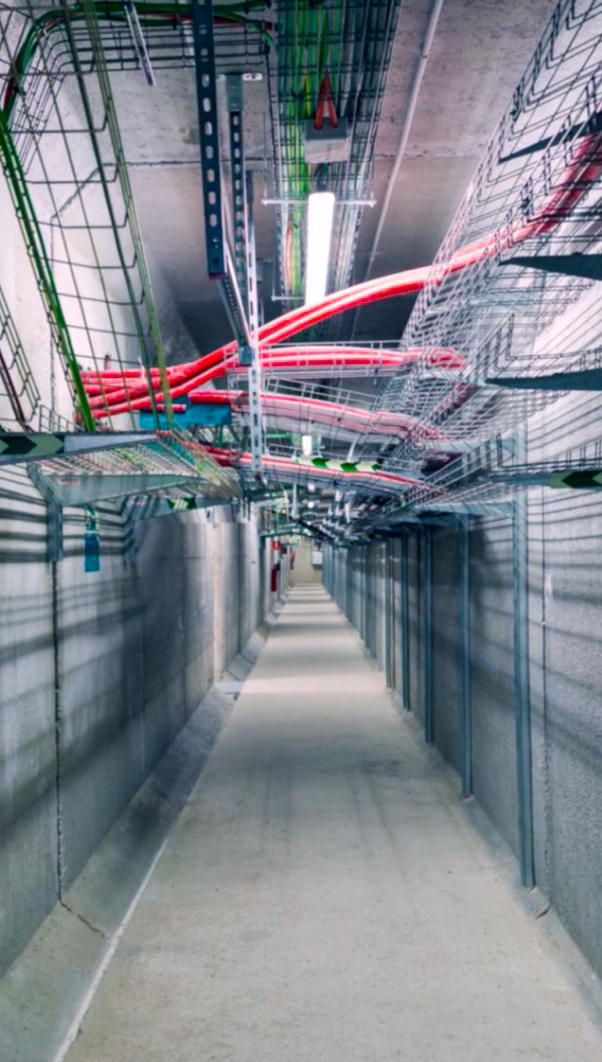
Timo Arnall
Internet Machine
“Internet machine is a multi-screen film about the invisible infrastructures of the internet. The film reveals the hidden materiality of our data by exploring some of the machines through which ‘the cloud’ is transmitted and transformed. The film explores these hidden architectures with a wide, slowly moving camera. The subtle changes in perspective encourage contemplative reflection on the spaces where internet data and connectivity are being managed. In this film I wanted to look beyond the childish myth of ‘the cloud’, to investigate what the infrastructures of the internet actually look like. It felt important to be able to see and hear the energy that goes into powering these machines, and the associated systems for securing, cooling and maintaining them.” Timo Arnall

Samuel Bianchini
At Present
Who has never contemplated drops of water seeking their path down a windowpane? Drops of water fall on a glass stele; they do not seem to be moving randomly, they wander, follow invisible bends and form letters and parts of letters; they provide glimpses of words […]
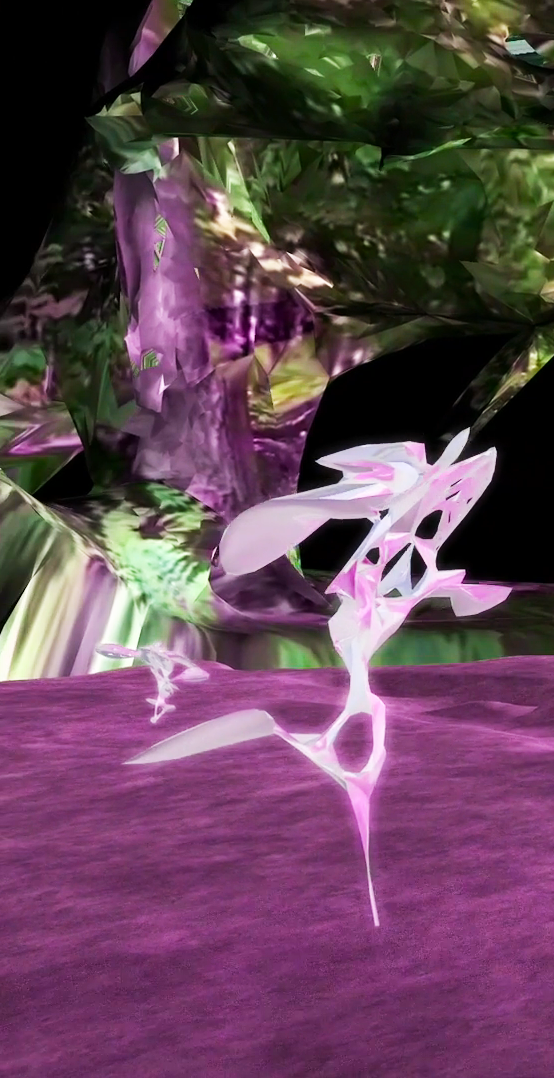
Isabella Münnich
Immersed Garden
Immersed Garden is in its true sense a sunken world. Floating bodiless in an underwater garden, natural sounds guide you through an immersive surrounding, somewhere between calming and irritating, natural and artificial. It is a playful exploration of the individual conception of safety and confusion and a personal approach to aesthetic references to habits of introspection and retreat in digital environments. It was created by fusing different digital processes like photogrammetry of selected natural places around Karlsruhe and field recordings in a local natural reserve. Underwater videos hybridize with 3D scans of trees and plants while invisible frogs are croaking and humming birds are buzzing by synthetic flowers. The artistic aim was to explore the personal perception of calming and irritating, playing with the concept of immaterialness and attentiveness. The artwork creates aesthetic references to philosophical and scientific theories of introspection and identity.

sarah oppenheimer
N-01
The artist creates an unprecedented visuospatial system that transforms the historical museum and its viewers alike.Visitors are kindly invited to touch and move the black metal and glass elements of the artwork.The built environment is inhabited through an array of inputs and outputs. Our bodies set in motion invisible chains of cause and effect. Enter a room: lights turn on. Turn a handle:a door opens. This relay is modulated through system controllers, devices programmed to respond to moving bodies and aural commands. Buried within walls, floors and ceilings, building networks are a black box.

Andrea Polli
Particle Falls
Particle Falls is a large-scale, real-time visualization of air-quality data.On a background of falling blue light, spots of bright, fiery color emerge and crackle, representing the presence of fine particulate matter, as detected by a nearby air monitor. Fewer bright spots over the falls mean fewer particles in the air.Particle Falls draws our attention to the invisible particles that surround us and that may affect our health. While the visible smog that plagued many U.S. urban centers decades ago has been mitigated by technology and regulatory measures, microscopic threats to our air continue to exist and often go unnoticed. Particle Falls is one way we can learn more about the quality of air around us.

Lisa Park
Eunoia II
It is an interactive performance and installation that attempts to display invisible human emotion and physiological changes into auditory representations. The work uses a commercial brainwave sensor to visualize and musicalize biological signals as art. The real-time detected brain data was used as a means to self-monitor and to control. The installation is comprised of 48 speakers and aluminum dishes, each containing a pool of water. The layout of “Eunoia (Vr.2)” was inspired by an Asian Buddhist symbol meaning ‘balance.’ The motif of number 48 comes from Spinoza’s ‘Ethics’ (Chapter III), classifying 48 human emotions into three categories – desire, pleasure, and pain. In this performance, water becomes a mirror of the artist’s internal state. It aims to physically manifest the artist’s current states as ripples in pools of water.

fuse
FALIN MYND
Falin Mynd is an audiovisual installation dedicated to the city of Milan that draws inspiration from the concept of the latent image in the photographic field: an invisible imprint left by the light on the film that is revealed only after its development. Similarly, the data generated by the inhabitants and visitors of the city of Milan produce abstract digital landscapes, leaving a trace from their analysis and interpretation in real-time. In this way, the work makes visible the indissoluble bond between individual and community, highlighting how the two entities influence one another changing the perception of the reality surrounding us made of places, people, colors, and sensations. The data thus constitute an invisible image of the city, a map of what is not manifest and which is revealed in Falin Mynd.
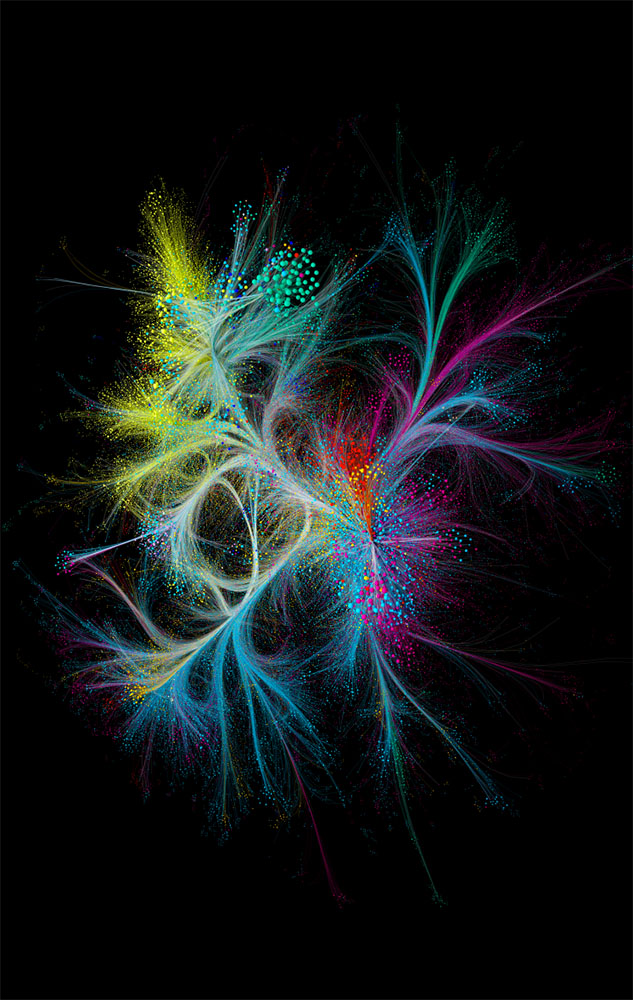
BarabásiLab
Hidden Patterns
The co-citation network for Nature: more than 88,000 papers published by the journal since 1900 are each represented by a dot, coloured by discipline. Papers are linked if another scientific paper (of those indexed in the Web of Science) cites both; the dot size reflects the number of these co-citation links.
Invisible, hidden connections and constantly repeating patterns within nature, society, language, and culture can not only be explored but also made visible. Barabási’s network approach promises to deliver a comprehensive, universal method that will illuminate many phenomena with scientific precision.

Pierre-Jean GILOUX
Metabolism _ Invisible Cities
Pierre-Jean Giloux’s first monograph, the publication extends the eponymous video tetralogy inspired by the Japanese utopian architectural movement: Metabolism (1960-70).
The films of the Invisible Cities cycle are portraits of Japanese cities, superimposing filmed and photographed images of everyday, social and urban reality, with virtual images.
The book explores the links in Pierre Jean Giloux’s work that connect four Japanese cities with a rich architectural past (Tokyo, Yokohama, Osaka, Kyoto). This jorney through Japan’s Megapolis traces the history of Japan and ends with the reconstruction of pavilions for the Osaka 70 Universal Exhibition and a virtual proposal for a smart city on the waters of Lake Biwa.
The metabolist utopia to which reference is constantly made in the work of Pierre Jean Giloux played a decisive role in the constitution of post-war Japanese cultural identity and had a notable influence on many contemporary architects.

Alisa Andrasek
Cloud Pergola
Inspired by the cloud formations and weather events, this mathematized cloud plays with visitor’s perception. Movement through the structure generates a series of dynamic interference views in its deep fabric, drifts and ruptures in visibility. A sea of redirecting vectors is pulling the visitor like an invisible gravity force through the fabric.

Rasa Smite & Raitis Smits
Swamp Radio
Swamp Radio gets beyond our anthropocenic reality, and maintains connections between the humans and other species. By artistic interventions and transmitting interfaces, the Swamp Radio is turned into a social media megaphone for invisible and inaudible actors of nature. The artists are installing microbial fuel cells, environmental monitoring sensors and transmitting devices to transform the swamps into dynamic power plants and the 21st century multi-voiced broadcast media.

Lien-cheng Wan
Reading Plan
“Reading Plan is an interactive artwork with 23 automation book flipping machines. When audiences enter the exhibition room, these machines will start to turn pages automatically and read the context at the same time. The updated figure to show that average student numbers per primary school in years 2016 in Taiwan is 23 students. I included a metaphor classroom in this artwork. In Taiwan, when people go to school, they don’t have much decision power to decide what they want to read and study. It is like being controlled by a huge invisible gear. The education direction led by authorities always prioritizes industry value and competitiveness. They want create a money-making machine instead of self exploration and humanism thinking.” Lien-cheng Wan
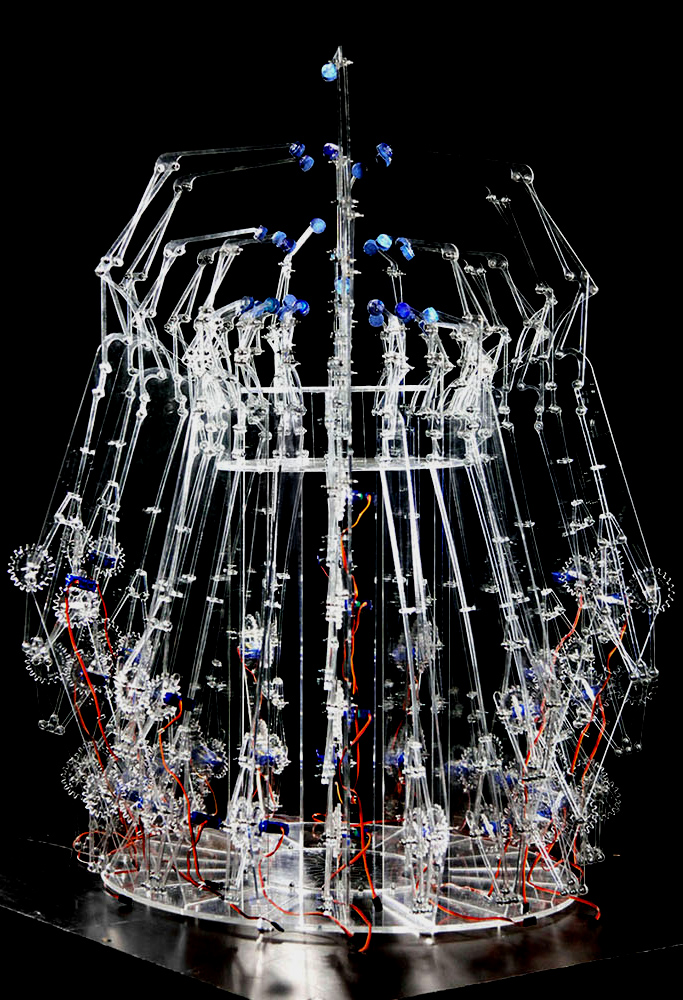
jeanine jannetje
reawaken
Reawaken is a kinetic sculpture with 55 robotic arms, powered by 55 servo motors. The lowering of the arms causes an abstract print on paper. Technology mirrors humanity, and vice versa. In addition to creating beauty, technology is there to meet our needs. We, and our needs, have evolved to a point where we are so integrated that we consume technology on autopilot. We live in a time of mass production in which our daily devices increasingly mimick each other. A smartphone is a small tablet, a tablet a small computer and a computer a small television. The question of what this does with our imagination, together with the increasingly invisible technological progress such as algorithms and artificial intelligence, have been my starting point for Reawaken.

Joanie Lemercier
Constellations
“Constellations” is an audio visual installation. Light is projected on invisible water particles to form shapes and intangible structures in the air. It’s an abstract journey through geometric structures formed by the universe.


So Kanno
Lasermice
“Lasermice” is a swarm robotic installation that consists of 60 small robots, which inspired by synchronous behavior from insects like fireflies. Normally network of swarm is invisible, But in this case those robots creates visible network via laser light – photodetector communication. As a result, they generates rythme that continuously changing. The generated rhythm is made audible by solenoid which strikes floor. Combination of visible network and audible rhythm are deployed spatially.

Jesper Just
CORPORÉALITÉS
Corporealités is a large-scale work exploring the autonomy of ballet through the immersive elements of sculpture and video. At the heart of a piece is Just’s film, displayed across a series of LED-panels strewn about the space, where close up shots of dancers from the American Ballet Theatre show their bodies affixed to electrotherapy patches. As the muscles displayed on the panels contract, notes of Fauré’s Op. 50 seem to play in tandem, providing an ominously invisible link between the film and physical space.
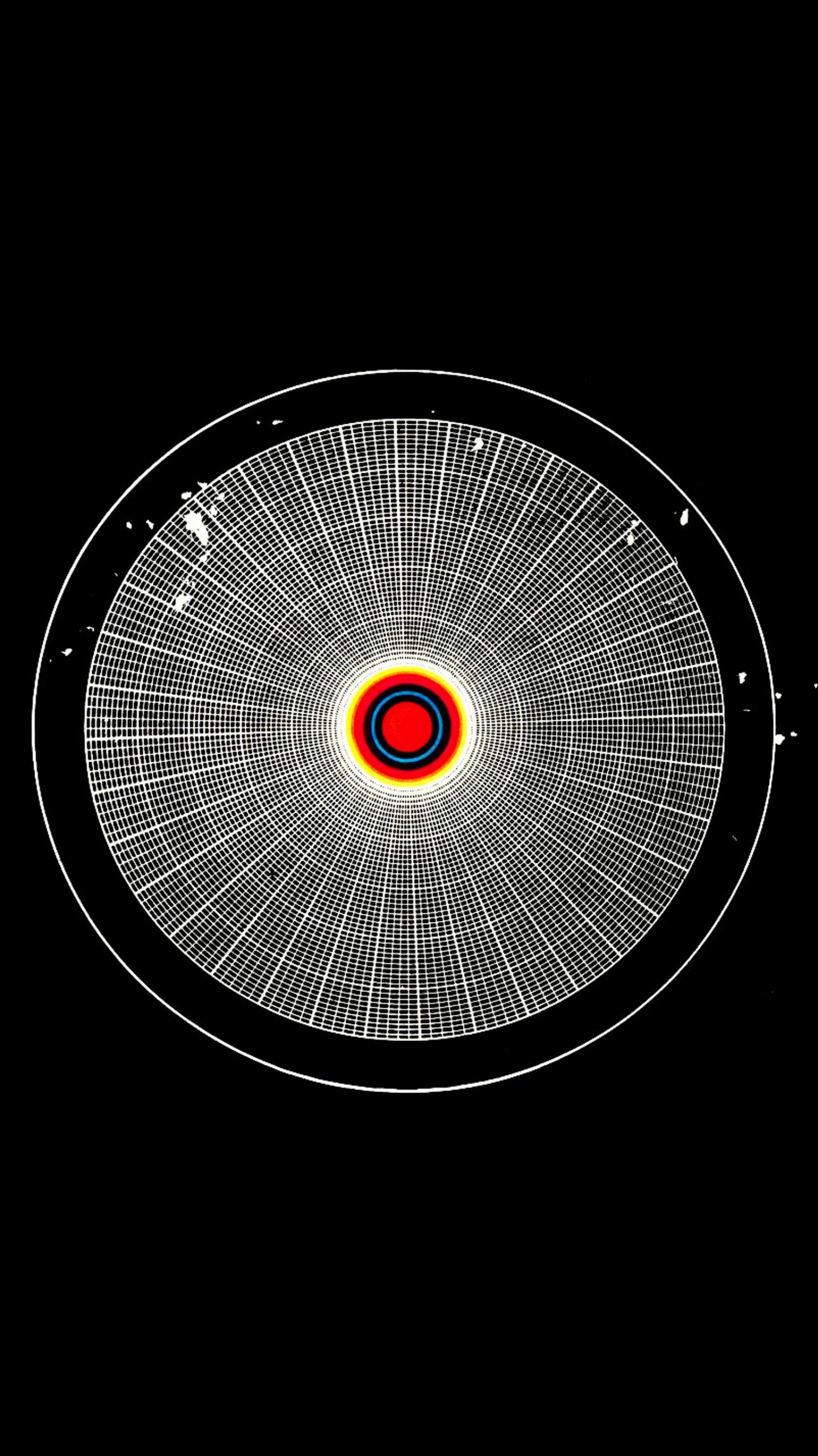
ANDREI TARKOVSKY
أندريه تاركوفسكي
塔可夫斯基
アンドレイ·タルコフスキー
Андрей Тарковский
Solaris
In Solaris (1972), Andrei Tarkovsky presents a vision of contemporary society as one that has become cut off from nature, and provides a narrative that illustrates the possibility of remaining human in the inhuman world that is the result. The film contrasts a life-affirming natural landscape to an urban, constructed landscape where the natural world is submerged and invisible. The Solaris space station is both a projection of this second, inhuman, landscape and an allegory for Tarkovsky’s view of urban life. The narrative of the film concerns the journey by the central character, Kris Kelvin (Donatas Banionis), from emotional deadness to a rediscovery of his humanity as he charts a course between these two worlds, and the role that art, whether painting, music or film, plays in this.
cinema full

ERNESTO KLAR
Эрнесто Клар
Convergenze parallele
Convergenze parallele is an audiovisual installation in which airborne dust particles passing through a beam of light are tracked, visualized, and sonified in realtime by a custom software system. The installation reacts to air movements in the exhibition space, allowing the viewer to see and hear the amplified movement of dust particles. “Convergenze parallele” explores the poetic potential of revealing and transforming the imperceptible. The custom software uses a video camera to capture the activity of dust articles passing through the beam of light. It then analyzes the video signal to track the location of individual dust particles, and reveals each particle’s trajectory in the image-processed projection. The physical particles draw traces of their otherwise invisible motion on the digital screen. At random intervals, the software artificially saturates the system by briefly activating the fan-a cloud of dust fills the beam of light and creates dense and stunning patterns of particle trajectories and sound.

ALICE HALDENWANG, LAURA COUTO ROSADO AND TINGTING ZHANG
Telepathy 2012-2112
“TELEPATHY” immerses the viewer in the heart of a fiction where telepathy would become the predominant means of communication at the expense of means of current communication. The ten glass helmets enable to visualize a telepathic communication, by definition invisible. “TELEPATHY” proposes to reverse the current trend which consists in basing its communication on technology, and in exchange it reveals the parapsychological and subjective communication of psychic phenomena.

JULIUS VON BISMARCK
versuch unter kreisen
This is the artistic result of a residency spent at CERN, where particles circulate on rings at great speed. The four lamps that are suspended from the ceiling also describe circles, but at varying speeds. Starting from there, every imaginable choreography is possible as well as every interpretation. The lamps describe figures that imperceptible transitions trigger one to the other. According to the artist, it’s only a question of mathematics here, though one asks oneself which one of the four incandescent lamps directs the others. And just as quick as they come into alignment as though linked by invisible ties, there is one that seems to accelerate while another can’t manage to keep up with the group. You can watch them for hours on end, hypnotised by the aesthetic beauty of physical laws. The artist, Julius von Bismarck, when receiving his prize admitted to having learned a lot at the CERN. It is likely that the scientists were also marked by his presence.
.

